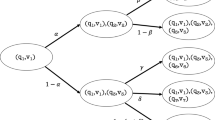Abstract
This paper presents a computationally fesible procedure for the optimalcontrol and stochastic simulation of large nonlinear models with rationalexpectations under the assumption of certainty equivalence.
Similar content being viewed by others
References
Amman, Hans M. and Kendrick, David A. (1999). Linear quadratic optimization for models with rational expectations and learning. Macroeconomic Dynamics, 3, 534-543.
Binder, Michael M., Pesaran, Hashem, M. and Hossein Samiei, S. (2000). Solution of nonlinear rational expectations models with applications to finite-horizon life-cycle models of consumption. Computational Economics, 15, 25-57
Clarida, Richard, Galí, Jordi and Gertler, Mark (2000). Monetary policy rules and macroeconomic stability: Evidence and some theory. The Quarterly Journal of Economics, 115, 147-180.
Clark, Todd E. (1994). Nominal GDP targeting rules: Can they stabilize the economy? Federal Reserve Bank of Kansas City Economy Review, 3, 11-25.
Croushore, Dean and Stark, Tom (1994). Evaluating McCallum's rule for monetary policy. Federal Reserve Bank of Philadelphia, November.
Fair, R.C. (1974). On the solution of optimal control problems as maximization problems. Annals of Economic and Social Measurement, 3, 135-154.
Fair, R.C. (1984). Specification, Estimation, and Analysis of Macroeconomic Models. Harvard University Press, Cambridge, MA.
Fair, R.C. (1994). Testing Macroeconometric Models. Harvard University Press, Cambridge, MA.
Fair, R.C. (2000). Estimated, calibrated, and optimal interest rate rules. Mimeo, May.
Fair, R.C. and Howrey, E. Philip (1996). Evaluating alternative monetary policy rules. Journal of Monetary Economics, 38, 173-193.
Fair, R.C. and Parke, William R. (1995). The Fair-Parke Program for the Estimation and Analysis of Nonlinear Econometric Models, August.
Fair, R.C. and Taylor, John B. (1983). Solution and maximum likelihood estimation of dynamic rational expectations models. Econometrica, 51, 1169-1185.
Fair, R.C. and Taylor, John B. (1990). Full information estimation and stochastic simulation of models with rational expectations. Journal of Applied Econometrics, 5, 381-392.
Feldstein, Martin and Stock, James H. (1993). The use of a monetary aggregate to target nominal GDP. NBER Working Paper No. 4304.
Finan, Frederico S. and Tetlow, R. (1999). Optimal control of large, forward-looking models. Board of Governors of the Federal Reserve System, October.
Hall, Robert E. and Mankiw, Gregory N. (1993). Nominal income targeting. NBER Working Paper No. 4439.
Judd, John P. and Motley, Brian (1993). Using a nominal GDP rule to guide discretionary monetary policy. Federal Reserve Bank of San Francisco Economic Review, 3, 3-11.
Levin, Andrew, Wieland, Volker and Williams, John C. (1999). Robustness of simple monetary policy rules under model uncertainty. In John B. Taylor (ed.), Monetary Policy Rules, 263-316. The University of Chicago Press, Chicago.
Rudebusch, Glenn (2001). Is the fed too timid? Monetary policy in an uncertain world. The Review of Economics and Statistics, 83, 203-217.
Taylor, John B. (1985). What would nominal GDP targeting do to the business cycle? Carnegie-Rochester Series on Public Policy, 22, 61-84.
Taylor, John B. (1999). Monetary Policy Rules. The University of Chicago Press, Chicago.
Thornton, Saranna R. (1995). Adaptive monetary policy rules utilizing either MZMorM2 and the effects of positive bias in money control errors, for presentation at the AEA Meetings, Washington D.C., January.
Author information
Authors and Affiliations
Rights and permissions
About this article
Cite this article
Fair, R.C. Optimal Control and Stochastic Simulation of Large Nonlinear Models with Rational Expectations. Computational Economics 21, 245–256 (2003). https://doi.org/10.1023/A:1023947827146
Issue Date:
DOI: https://doi.org/10.1023/A:1023947827146




